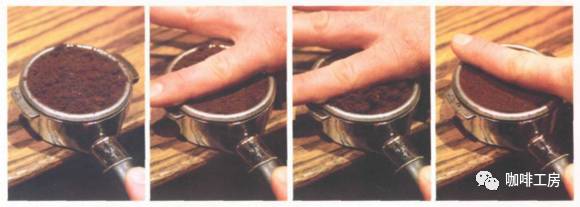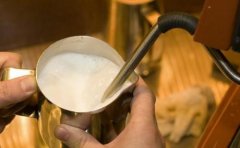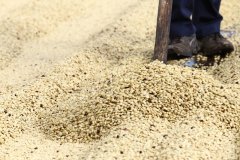The importance of correct gestures and uniform distribution of coffee cloth powder is much greater than that of pressing powder.

When brewing coffee, the hot water should slowly soak the coffee powder and have a stewing effect in a short period of time. Extract the essence of the coffee liquid and then filter it. If the coffee powder is spread unevenly, it will cause the places with less powder to soak quickly and the extraction time will be insufficient. While the places with thick powder are soaked slowly, it may cause excessive extraction, which will affect the taste of the coffee.
Filling powder and cloth powder
Different from other coffee professionals, the author believes that filling powder and cloth powder is a whole link, because most of the time, the cloth powder of the powder bed has already been completed when filling powder. The barista's goal in the powder filling and powder distribution phase is to provide a consistent amount of powder filling for each product, as well as a uniform distribution of volume and density. The difference in the amount of powder filling will lead to the change of flow rate, and the uneven distribution of powder will lead to uneven extraction.
If baristas can only have one of the most important skills, it is also consistent to create a powder bed with uniform cloth powder. Once the powder filling begins, the cloth powder begins, so careful powder filling is the key.
How to fill powder
The following is an example of a powder filling process:
1. Remove the handle from the espresso machine.
two。 Knock out the used pressed powder.
3. Dry the inside of the powder bowl with a dry rag. If there is water left on the edge of the powder bowl, it will make the edge of the powder bed produce a channel.
4. Make sure that every filter hole in the powder bowl is empty.
5. Start the bean grinder. If the grinding speed of your bean grinder is very slow, you may need to start the bean mill in the first step.
6. Repeatedly circle with the handle to make the coffee powder fill the bowl as evenly as possible. If one area has more powder than another, the area with more powder will be more compact, even after trimming.
7. After grinding the right amount of coffee powder, turn off the bean grinder.
8. Stop filling powder when the powder in the bowl has reached the expected amount. This amount can be exactly the amount of powder needed for extraction, or a little more, and the excess powder can be removed during dressing. No matter how much powder you choose, the most important thing is to keep the same amount of powder in each serving.
The skill of filling powder
No matter which powder filling technique you use, sprinkling only a little powder each time you move the handle is always easier to get a uniform cloth powder than dropping a large amount of powder. Using one or two powder filling techniques can improve the work efficiency of a busy cafe.
1. The cake filling method. Think of the powder bed as a cake, cut into wedge-shaped pieces. When filling powder, aim at the powder bowl, fill each "small piece" separately, and fill the next adjacent piece by moving the handle. Move, fill, and repeat in this order.
two。 Stratification method. When receiving the powder, sprinkle a small amount of coffee powder from the edge of the powder bowl, and constantly circle with the handle to form a shallow and uniform layer of coffee powder. Repeat this action to build the second layer on the first layer. Keep raising the floor until the amount of powder in the powder bowl reaches the desired target.
↑ forms a powder layer by constantly circling it with a handle, always filling it at the lowest point of the powder bed.
Trimming
The barista should trim the powder after filling and before pressing the powder. The dressing process includes redistributing the powder on the top of the powder bed (for the entire powder bed when using the Weisscloth powder technique), removing excess coffee powder when the barista thinks there is too much powder, and smoothing the surface of the powder bed before pressing it.
Techniques for trimming
Nowadays, many common dressing techniques are widely used, each of which has its own advantages and disadvantages.
1. North-South East-West (NSEW) method (don't be confused with the powder pressing technique of the same name). North, South, East and West methods are easy to learn and fast enough for busy cafes.
Use your fingers or ruler to push the stack of coffee powder toward the farthest part of the bowl (that is, the "north"). Don't push over the edge of the powder pile. Then push to the near side (south), then to the right, then to the left. Finally, push all the extra powder out of the edge. At this time, the surface of the powder bed should be smooth and smooth, without any trace or obvious difference. The point of using the NSEW method is that the amount of "excess" powder that needs to be trimmed each time is fixed. The weight of coffee powder piled up before dressing has a great influence on the density of the powder bed after dressing. Although the final results all look the same, the powder beds with more powder piled up before finishing will have a higher density after dressing.
↑ first pushes the powder pile to the far side of the bowl (north), then turns back (south), then to the right (east), and then to the left (west), pushing all the excess powder out of the edge before pressing the powder.
two。 Stoke Fleet shift method (Stockfleth's Move). The Stoke Fleet movement may be the most difficult trimming technique to master, but it is especially easy to use after mastering it. First of all, make the powder bowl slightly overfilled with powder. With both elbows outward, hold the handle in front of the torso. Hold out a straight finger, or from thumb to index finger, and gently place it on the powder pile. Turn the elbow in so that the handle and the hand move in the opposite direction. At this point, the stacked coffee powder will move around the center of the powder bowl. Repeat this action until all areas are filled and pressed. Before pushing the excess powder out of the edge, you can also use the NSEW method to smooth the surface of the powder stack.
↑ first let the elbow outward, and then to recycle the elbow, so that the stack of coffee powder moved toward the center of the powder bed. Repeat this action 2 to 3 times.
↑ pushes the excess coffee powder out of the edge before using the NSEW method.
3. Weisbu powder skill (WDT). Pioneered by JohnWeiss, WDT has a magical effect on caking and uneven cloth powder. The first step in operating a WDT is to insert a funnel from the top of the powder bowl (John recommends using a small yogurt cup with the bottom cut off). Put the coffee powder into the powder bowl until there is a little overflow. Stir the coffee powder evenly with a slender pointed object (such as a long needle or a straightened paper clip). After the funnel is removed, the powder pile is repaired by NSEW method or Stoke Fleet moving method, and then pressed powder. Another way is to put the coffee powder in a separate container, stir it and then fill it into a powder bowl. This method allows the handle to be separated from the cooking head for a shorter time, so it allows the powder bowl to maintain higher calories.
There are two great advantages to using WDT, which is that after the coffee powder has been filled into the powder pile, it can also break the cakes and redistribute the whole powder pile. The downside of WDT is that it may be a little too time-consuming for busy cafes.
↑, ugh! A lot of caking! Use a straight paper clip to stir violently to break the cakes, and finally get fluffy, non-caking coffee powder.
Trim a shallow pile of powder
All the trimming techniques mentioned above are based on enough coffee powder to fill the powder bowl. When the amount of powder does not reach the edge of the powder bowl, it cannot be trimmed with fingers or tools. To trim a powder pile with less powder, baristas have two options: one is to use a curved tool, and the other is to change to a smaller powder bowl (Note 5: use the curved tool to trim the powder bed, the surface will be sunken. After pressing the powder, the density around the powder bed will be higher than that in the central area, which is actually not ideal. However, because the channel is most commonly found in the area around the powder bed, this part can prevent one of the factors that are most likely to produce the channel. Powder beds trimmed with curved tools rarely produce large channels, and the final products are usually good, but not perfect).
↑ uses the lid of the powder cartridge or other curved objects to trim the shallow powder heap. The greater the Radian of the curved surface (or the smaller the object of the curved surface), the better it is to handle a smaller amount of powder.
Shallow piles of powder can be trimmed with raised curved tools (such as the lid of the powder compartment of a bean mill). You can place the tool on the edge of the powder bowl, use the NSEW method to slide the tool, and then push the excess powder out from the edge. You can also place the tool on the centerline of the powder bowl and turn it around or two in a way similar to the Stoke Fleet movement. The excess coffee powder can be extruded from the edge of the powder bowl using a curved tool.
When using smaller powder bowls, there is no need to prepare specific dressing tools. For example, 15g of powder may be too shallow for a double bowl, but a double bowl from another manufacturer may be flush with the edge. If you are used to using straight ruler-shaped tools for trimming operations, it is worth having different sizes of powder bowls.
Important Notice :
前街咖啡 FrontStreet Coffee has moved to new addredd:
FrontStreet Coffee Address: 315,Donghua East Road,GuangZhou
Tel:020 38364473
- Prev

The milking pressure and extraction pressure of Italian coffee machine are not the same parameter.
Communication of professional baristas Please follow the coffee workshop (Wechat official account cafe_style) High pressure steam coffee machine is a kind of Italian coffee machine. Italian coffee machine is divided into steam Italian and pump Italian, steam Italian refers to the so-called high-pressure steam, but the pressure is only 3-5BAR (1BAR=1 atmospheric pressure), can only make coffee a little stronger than the American drip coffee machine, but can not do it.
- Next

What is the moisture content of raw coffee beans? What does it mean to bakers and farmers?
Communication of professional baristas Please pay attention to the quality control during drying in the coffee workshop (Wechat official account cafe_style) Coffee cherries have an uneven ripening tendency on the coffee trees at the same time, some flowers may still be hanging, and some cherries are already red. On most professional farms, crops will be checked at multiple points during harvest and mature coffee will be selected when mature.
Related
- Beginners will see the "Coffee pull flower" guide!
- What is the difference between ice blog purified milk and ordinary milk coffee?
- Why is the Philippines the largest producer of crops in Liberia?
- For coffee extraction, should the fine powder be retained?
- How does extracted espresso fill pressed powder? How much strength does it take to press the powder?
- How to make jasmine cold extract coffee? Is the jasmine + latte good?
- Will this little toy really make the coffee taste better? How does Lily Drip affect coffee extraction?
- Will the action of slapping the filter cup also affect coffee extraction?
- What's the difference between powder-to-water ratio and powder-to-liquid ratio?
- What is the Ethiopian local species? What does it have to do with Heirloom native species?

